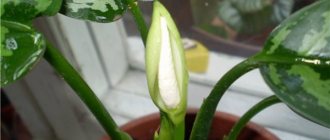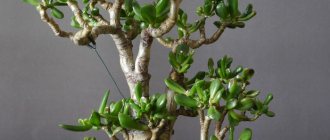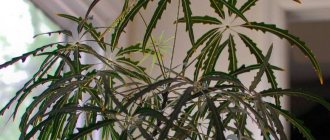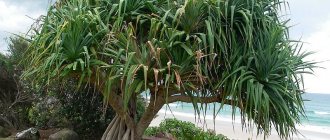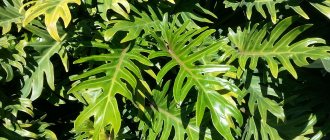Spider mite Scale insects Mealybug
Below you can see a photo of the tricolor arrowroot or prayer plant:
Home care
Caring for arrowroot at home is no different from most other plants.
When purchasing, you should carefully inspect the plant, refusing to purchase heavily overgrown, old or, conversely, young ones that have not yet gained strength, as well as weakened seedlings.
Important! The optimal time to start cultivating the flower is April - May.
Having delivered the arrowroot home, it should be protected from the harmful effects of dry room air. For this purpose, the plant is sprayed with settled warm water from a spray bottle several times a day until it adapts to its new conditions.
By the way, such hydroprocedures are necessary for a flower throughout its entire growing season: at least once a day in winter, and twice a day in summer.
Problems during cultivation
If you care for arrowroot incorrectly, it can get sick. We tried to collect for you the most common symptoms of arrowroot grown at home, and tips on how to return the plant to its healthy appearance.
- The tips of the arrowroot leaves are drying out. This happens if the air in the room is too dry. In this case, the leaves may fall off and the growth of the plant will stop. Start spraying the plant more often with a spray bottle, place a tray with wet expanded clay, or move the flower to a room with an aquarium.
- The leaves lose their color and become faded. This is how arrowroot reacts to direct sunlight. Create more shade with curtains and move the pot further into the room.
- If the stems and leaves of the arrowroot wither and rot, then most likely you are watering your beauty too much, and with cold water. Reduce watering, use only warm, settled water. If this does not help, remove the plant from the pot and trim off the rotten areas of the root. Treat the cut areas with crushed coal and root formation stimulator. Plant in a new pot with new soil.
- Arrowroot leaves turn yellow and dry, sometimes curling. Frequent exposure of the plant to drafts often leads to this result.
- The arrowroot leaves have stopped rising (the flower is no longer praying). If you have an old copy, then this is normal. If not, it looks like your bush is too crowded in the pot and it’s time to replant it.
- Yellow or light brown spots appear on the leaves. This could be sunburn. Check to see if your arrowroot is exposed to direct sunlight. In addition, inspect the flower for parasites.
This may be interesting: Schefflera - home care
Pests
Mealybug. White fluffy lumps appear on the leaves and shoots of arrowroot, under which there is an insect. Arrowroot leaves fade and die
Gently wash off the parasites with a sponge and soapy water. Then spray with Actellik insecticide according to the instructions.
Repeat the procedure until the parasites completely disappear from your flower.
Shield. Brownish growths on the back of the leaves. Gradually they dry out and fall off. Remove scale insects manually with a damp cloth. Treat arrowroot with Fitoverm. Repeat the procedure until the insects stop appearing again.
Thrips. Small insects and small black dots appear on the back of the leaves. Thrips lay eggs in the ground. Adult insects can be washed off with water. To destroy the larvae, water the soil with Aktara solution once a week for 3-4 weeks.
Spider mite. Easily recognized by the white cobwebs on the leaves. The leaves lose color and dry out, which is sometimes accompanied by the appearance of reddish spots. Cover the soil with film and bathe the arrowroot in the shower. Then spray the plant with Fitoverm or Derris.
Watering and spraying
Arrowroot requires abundant and regular watering to prevent excessive drying of the soil.
However, excess moisture in the substrate can be detrimental to the plant, as it leads to rotting of the root collar. Usually in summer watering is carried out every other day , and in winter - 1-2 times a week. For this procedure, use only rain, snow, boiled or settled tap water.
A reliable indicator of the need for regular watering is drying the surface layer of soil to a depth of 2 cm .
Spraying also has a beneficial effect on the plant, especially in summer.
Important! In some cases, this procedure can lead to the appearance of white streaks on the leaves. As an alternative to a wet shower, you can install plastic trays or other containers with gravel or expanded clay filled with water next to the arrowroot.
Landing
a shallow but wide ceramic or plastic pot is best This is explained by the fact that arrowroot roots do not penetrate deep into the soil, but form additional underground tubers that require sufficient free space for their development.
To grow healthy and beautiful indoor plants, it is worth preparing a balanced, breathable substrate that has a slightly acidic reaction environment.
For the latter, either ready-made store-bought formulations or self-prepared mixtures are used. The following option has worked well:
- 2 parts peat;
- 1 part coarse river sand;
- 2 parts leaf humus.
This universal mixture also deserves special mention:
- 2 parts peat;
- 4 parts leaf humus;
- 1 part rotted manure;
- 1 part river sand.
To make the substrate more loose, you can add pine bark, sphagnum, crushed charcoal or coniferous soil . Additionally, drainage is arranged by pouring expanded clay, broken brick or small crushed stone into the bottom of the flower pot in a layer of up to 5 cm.
The video shows the main points of flower care:
Reproduction
There are several ways to propagate the plant.
- Dividing the bush . In this case, when transplanting arrowroot, the mother rhizome is divided into several daughter tubers with well-developed roots and leaf blades. Young individuals are planted in separate containers with loose, light soil and covered with cellophane film or a plastic cap for better survival. After this, the pots are placed in a warm place for final rooting of the plants.
- Cuttings . From the apical shoots, take a section of the stem 8–10 cm long with two internodes and several healthy leaves, and then place it in a container with settled water. To speed up the formation of roots, the cuttings are treated with a growth stimulator. The germination process usually takes 1 – 1.5 months. After this, the cuttings are transplanted into a breathable peat-sand substrate and watered well. For quick rooting of seedlings, small greenhouses are set up.
Biological characteristics of arrowroot
Arrowroot (Maranta) belongs to the genus Marantaceae - perennial herbaceous ornamental deciduous and beautifully flowering plants, of which there are about 400 species. Under natural conditions, they rarely grow above 20 cm, but some cultivated species can reach 1.5 meters.
The genus Maranta consists of only 20 species. Its representatives are distinguished by spectacular leaves, which are located on long petioles, often coming straight out of the ground. Their size rarely exceeds 13–15 cm. They can be oval or oblong-lanceolate. The color of the front side of the leaf blades varies from silver-white to dark green, almost black; reverse - from light green to burgundy red. The surface always has patterns formed by spots and brightly colored veins.
The root system of arrowroot consists of a tuberous or oblong rhizome, which serves as a water storage facility during periods of drought, and thin roots that supply the plant with moisture and nutrients. Thin herbaceous stems of bushes usually form with age. They can be either creeping or erect.
Lighting
Arrowroot does not tolerate direct sunlight, however, strong shading also negatively affects its appearance: the leaf blade decreases in size, losing its rich greenish color.
Plants feel best either in bright diffused light (partial shade) or in artificial lighting with fluorescent lamps for 16 hours a day.
Important! The ideal location of the flower indoors will be the central part of the room, and in winter - the windowsill, where the plant will receive more solar energy.
Benefits and harms
The decorative form of this plant is valued by gardeners for its beautiful rosette of oval leaves, the color of which is dominated by various shades of green, complemented by an accent in the form of bright veins, stripes and spots.
A close relative of this flower, reed arrowroot, is widely used in cooking. Here, underground tubers rich in starch (up to 25%) are used. From them, flour is obtained, which is used to prepare nutritious puddings, sauces, soups, stews and baked goods.
Various types of arrowroot also have healing properties. It is believed that a pot with a living plant placed next to your sleeping place can cure insomnia . A number of amateur flower growers believe that it harmonizes the internal living space, helps cope with bad moods and attacks of aggression, and smoothes out quarrels.
Arrowroot does not have a , since it does not secrete toxic milky juice and does not have sharp edges that lead to cuts.
Important! In any case, caution must be exercised by people suffering from severe forms of allergic diseases and bronchial asthma.
What does tricolor arrowroot look like, what family does it belong to?
Arrowroot is an evergreen perennial belonging to the arrowroot family, which includes 25 species. The plant is named after the Venetian physician and botanist Barthalomeo Maranta. Habitat: tropical rainforests of South America. In addition to the name tricolor, the plant has other names. Arrowroot tricolor, fascinator, red-veined and even prayer, all these are links in one chain.
Appearance of tricolor arrowroot
Additional Information! The name “prayer” arrowroot is associated with the arrangement of the leaves depending on the lighting. Under comfortable conditions, the leaves are arranged horizontally. If the containment regime is violated, they rise up.
Common varieties
Description of varieties of arrowroot fascinator:
- Tricolor (Tricolor) arrowroot grows up to 40 cm, slightly less in width. Velvety oval-shaped leaves, 12 cm long, planted on short petioles, give the plant a special charm. The center of the leaf is green, the edges are lighter. Red-crimson veins stand out on the greenery; a light jagged stripe with dark streaks runs along the central one. The other side of the leaf is lilac-violet in color.
- The two-color arrowroot is less known, but just as in demand as the three-color specimen. It has no roots, neat and small. The leaves are oval, compact, smoothly rounded at the edges. The green color is dissected with white stripes along the veins. The flowers are small, white with dark dots.
- Massanja (Black arrowroot). Dark green leaves appear black. The vein and stripes are silvery. The variety is capricious, which is why it is almost never grown at home.
- Kerkhove arrowroot with small oval leaves 15 cm long. White stripes with dark spots run along the leaf blade. The reverse side of the sheet is blue. The leaves sit on short petioles.
There are other interesting varieties, but less popular for home cultivation.
Additional Information! Arrowroot is grown at home in the form of a bush in a pot or hanging basket, as an hanging plant.
Growing arrowroot in a hanging basket
Medicinal properties
The medicinal properties of the plant have been sufficiently studied. Tubers contain a lot of starch and cellulose. The flowers are used in dietary nutrition and as a general tonic. The glassy root is in demand in the manufacture of baby food products and is used to prevent thrombosis and thrombophlebitis. However, if cultural elements are intolerant, there is no point in taking risks.
Diseases and pests
Spider mite
This is one of the most dangerous plant pests. It settles on the underside of the leaf blade, causing the appearance of white spots and a thin cobweb. Over time, the leaves lose their usual color and fall off.
To prevent this phenomenon, it is necessary to avoid excessive dryness of the air in the room by periodically spraying the flower with water. When the disease has already developed, special insecticidal preparations are used, in particular “Fitoverm”, “Aktellik”, “Funanon”, etc., as well as pollination with sulfur preparations in the open air outside the living room.
Shields
A sign of damage by this pest is the appearance of brown protrusions on the leaves and stems. The leaf blade dries out, curls, loses its characteristic color and falls off (read more about what to do if arrowroot leaves turn yellow and dry, as well as what diseases and pests can destroy a flower and how to treat the plant).
A radical means of combating this disease is either washing the affected areas of the plant with a 5% soap emulsion (20 grams of laundry soap per 10 liters of water), or spraying with an Actellika solution prepared at the rate of 1 - 2 ml of product per 1 liter of water.
Mealybug
It primarily affects leaf petioles. To destroy it, the same drugs are used as in the case of scale insects. If necessary, treatment is carried out repeatedly until a lasting result is achieved.
Arrowroot tricolor is not a simple plant, since its normal growth and development requires strict adherence to cultivation techniques. However, all these efforts will pay off handsomely, because “praying grass” is one of the most beautiful tropical plants that will delight the eye with luxurious velvety leaves with a unique pattern for many years.
3. Varieties of arrowroot:
3.1.Arrowroot tricolor, tricolor or fascinator - Maranta tricolor
A small herbaceous plant - a subspecies of the variegated red-veined arrowroot, with very attractive bright, oval leaves. The main tone of the leaves is dark green, velvety, the surface of the leaf plates near the central vein has a light green or even yellow tint, the lateral semicircular veins are highlighted with thin pink lines, and the lower surface of the leaves is often painted in a burgundy tint.
↑ Up,
3.2. White-veined arrowroot - Maranta leuconeura
A valuable decorative foliage, compact plant with large, painted leaves of all shades of green with a regular geometric pattern. As the name suggests, the veins are often highlighted in white. The underside of the sheet plates can be painted either in a lighter shade - for example, a silver tint, or in a contrasting burgundy color. Flowering is unattractive.
↑ Up,
3.3. White-veined arrowroot "Kerchoveana" - Maranta leuconeura Kerchoveana
Evergreen white-veined arrowroot 30 - 45 cm high with lodging stems. The leaves are oblong-oval, bluish-green, arranged alternately. Large brown or dark green spots are located on the surface of the leaf blades. The flowers are white, inconspicuous.
↑ Up,
3.4.Black arrowroot Massangeana - Maranta leuconeura “Massangeana”
A beautiful, but very finicky bush species. Large oval leaves are colored mint near the central vein; around this light spot there is a dark brown - almost black stripe. The outer edge of the leaf blades is painted in a bluish-green tint, along which there are light stripes along the veins.

